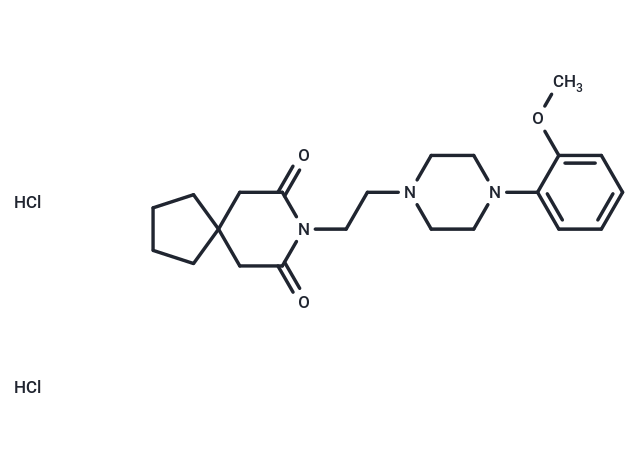Shopping Cart
- Remove All

Your shopping cart is currently empty


| Pack Size | Price | Availability | Quantity |
|---|---|---|---|
| 5 mg | $37 | In Stock | |
| 10 mg | $50 | In Stock | |
| 25 mg | $81 | In Stock | |
| 50 mg | $103 | In Stock | |
| 1 mL x 10 mM (in DMSO) | $50 | In Stock |
| Description | BMY 7378 dihydrochloride (BMY7378 HCl) , α1D-adrenergic receptor antagonist, is a weak partial agonist/antagonist of 5-HT1A receptor. |
| Kinase Assay | Phosphatase activities are determined on immunoprecipitates of the phosphatases. Briefly, 2×106 K562 cells are treated for 18 hr with Salubrinal (20 μM), PSI (10 nM), the combination of both drugs or okadaic acid (100 nM). After washing with PBS, cells are lysed for 15 min on ice either in PP1LB (for determination of PP1γ-activity; 20 mM Tris-HCl, pH 7.5, 1% Triton X-100, 10% glycerol, 132 mM NaCl, Roche complete protease inhibitor ) or in RIPA (for PP2A), supplemented with Roche complete protease inhibitor). Cell lysates containing 500 μg (PP1γ) or 300 μg (PP2A) protein are immunoprecipitated overnight at 4°C with 2-3 μg of the appropriate antibodies and then incubated with Protein A-Sepharose. Immunoprecipitates are washed three times in lysis buffer, followed by resuspension in phosphatase assay buffer (PP2A: 20 mM Tris-HCl, pH7.5, 0.1 mM CaCl2; PP1γ: 50 mM Tris HCl pH 7.0, 0.2 mM MnCl2, 0.1 mM CaCl2, 125 μg/mL BSA, 0.05% Tween 20), supplemented with 100 μM 6,8-difluoro-4-methyl-umbelliferyl phosphate (DiFMUP). Precipitates are allowed to react with substrate for 1 hr at 37°C on an Eppendorf Thermoshaker, centrifuged and DiFMU fluorescence is measured on a BioTek Lambda Fluoro 320 microplate reader (360 nmex/460 nmem). Phosphatase activities are given as percent change relative to the control (DMSO treated cells)[1]. |
| Alias | BMY7378 HCl |
| Molecular Weight | 458.42 |
| Formula | C22H33Cl2N3O3 |
| Cas No. | 21102-95-4 |
| Storage | Powder: -20°C for 3 years | In solvent: -80°C for 1 year | Shipping with blue ice. | ||||||||||||||||||||||||||||||||||||||||
| Solubility Information | Ethanol: 16 mg/mL (34.9 mM) DMSO: 85 mg/mL (185.4 mM) H2O: 84 mg/mL (183.2 mM) | ||||||||||||||||||||||||||||||||||||||||
Solution Preparation Table | |||||||||||||||||||||||||||||||||||||||||
Ethanol/H2O/DMSO
H2O/DMSO
| |||||||||||||||||||||||||||||||||||||||||

Copyright © 2015-2024 TargetMol Chemicals Inc. All Rights Reserved.